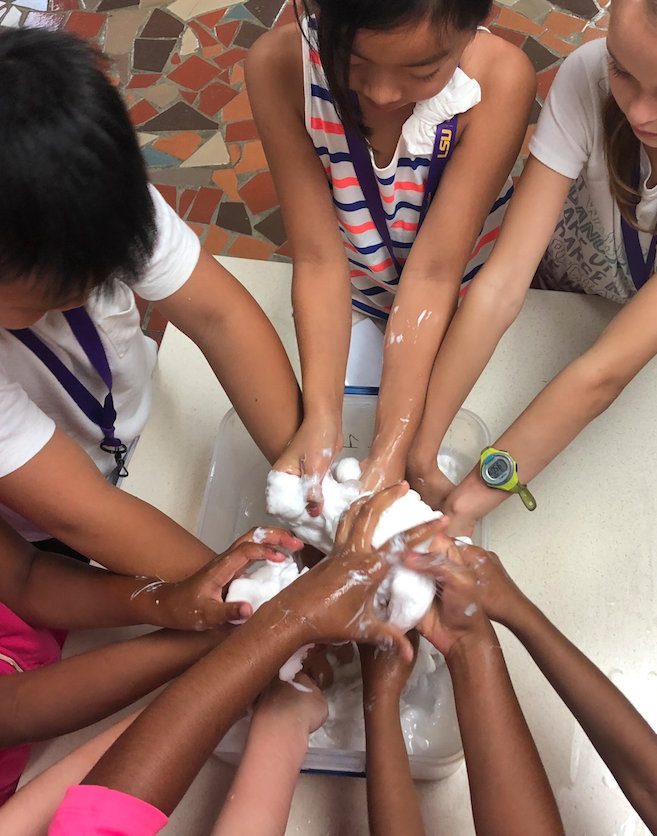ChemDemo Program
The ChemDemo Program was initiated by Prof. George Stanley in the Fall of 1997. Since 1997, we have sent out more than 13,000 LSU students who visited about 6,500 classrooms impacting over 162,000 K-12 students.
We currently have several sets of tested, safe demonstrations for the LSU students to choose from that usually, involve hands-on participation of some or all of the students in the classroom that is being visited. We provide detailed instructions for each set of experiments that includes a list of chemicals and items needed, how to perform and explain the science behind the demonstration, presentation tips, and connections of the chemistry/science involved in everyday life. Please contact us if you would like to either participate in ChemDemo or request ChemDemo presentations in your classroom or other events!
Featured Videos
Erupting Pumpkin
Lava Lamp
Sticky Spider Webs
Chemistry of Fireworks
Instructions for Student Volunteers
LSU students interested in participating in ChemDemo must commit to the following:
- Select the ChemDemo lesson you would like to present.
- Select a K-12 partner of your choice and coordinate with him/her to find the best day/time to do the science demonstration.
- Schedule the date and time(s) of your K-12 class presentation(s), complete the ChemDemo Kit Request Form.
- If your demonstration requires dry ice or liquid nitrogen, a Dry Ice/Liquid Nitrogen Request and Safety Form will be emailed to you after you submit your kit request. You will also be required to bring a signed Liquid Nitrogen Safety Information Form when you pick up your supplies.
- Fill out the Student Travel Form.
- Review and practice your presentation.
- Pick up your demo kits at the requested time from 610 Choppin Hall.
- Deliver your demonstration presentation to your K-12 class(es)
- Return your demo kit as instructed.
Classroom Demonstrations
Grades K-4
This experiment involve using liquid nitrogen (LN2) to let the students "see" the major components in the air around us. LN2 has a temperature of -196°C and freezing and shattering a flower is impressive. Pouring LN2 into an empty soda can causes a thin layer of liquid oxygen to form on the outside and drip off. CO2 is one of the things we exhale and solid CO2 can be dropped in a container of water to make a "witches brew" effect. Having the students blow air into the LN2 causes water vapor to condense out making "clouds".
Grades K-4
This is a "fun" activity and can be combined with "The Atmosphere" demo to provide a treat for a class.
Grades K-4
When Styrofoam is added to acetone (a common organic solvent) it very rapidly dissolves, making it look like it is disappearing. Starch-based packing "peanuts", on the other hand, will not dissolve in acetone, but do readily dissolve in water. Environmental consequences of these two properties will be discussed with the class. The melted plastic can be recovered from the acetone to make hard styrofoam plastic (illustrating recycling).
Grades K & Up
Adding Elmers School glue (or generic brand School Glue) to a water/borax solution causes a chemical reaction between the glue molecules (polyvinylacetate) and the borax molecules (Na2B4O7*10H2O) to produce a highly flexible, cross-linked polymer. This is similar to silly putty (real silly putty is a polymer based on organosiloxy groups and doesn't dry out). A hands-on experiment that all students in the class will do.
Grades 3-6
NaHcO3 and vinegar is used to shoot a cork out of a bottle demonstrating that some acid-base reactions generate gases like CO2. A voice-activated chemical reaction (speaking into a flask containing base and an indicator that changes color once enough CO2 is introduced); pH color changes are illustrated using a basic solution, universal indicator and solid CO2; the reaction of a metal and acid is shown using Mg and Sprite.
Grades 4-12
The properties of electricity are discussed and demonstrated with a Tesla coil and a simple generator allowing the students to turn work into electricity/light. Chemical reactions to make electricity, heat, and light are also performed. The ability to convert one form of energy into another is illustrated and discussed.
Grades 4-12
Experiments with "quantum fireballs" (burning metal colors), chemiluminescence, and burning magnesium in dry ice.
Grades 6-12
Stoichiometry concepts are explored by students making soap bubbles using various ratios of O2 and combustible gases such as H2, CH4, and CH3CH2CH3 (propane) and then igniting them. The loudest "bang" indicates the correct stoichiometry. Overall chemical reactions can be worked out and an unknown gas identified.
Questions?
Contact Prof. Matthew Chambers (chambers@lsu.edu).
Funding
External support for this program has been increasing with donations from the Albemarle Foundation, the Baton Rouge local section of the American Chemical Society, and ExxonMobil. BASF and the LSU Cain Center for STEM Literacy are also supporting ChemDemo via financial support or donations of specialty materials.
In you are interested in making a donation to the LSU ChemDemo program, please contact the LSU Foundation.
